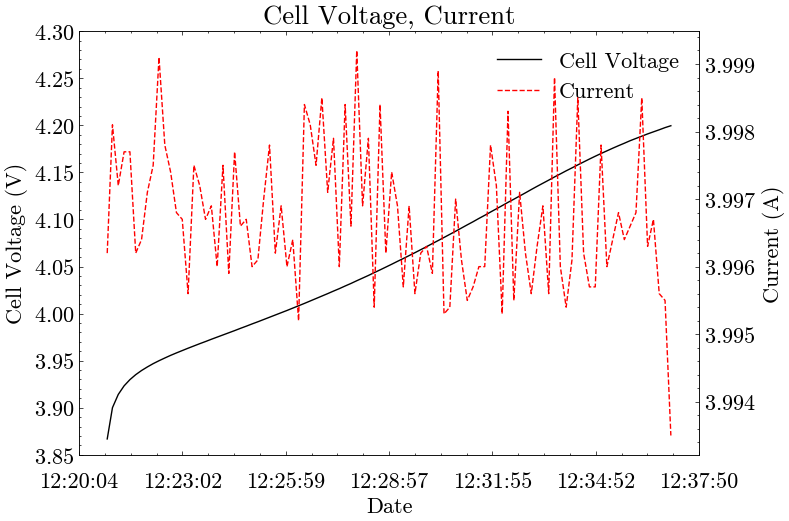1.13. plot
Implements a cli tool to plot measured data. This tool extracts data from files and plots it as a line graph according to a given specification.

Fig. 1.4 Example Graph - Cell Voltage, Current
1.13.1. Usage
Usage: fox.py plot [OPTIONS] INPUT_DATA...
Run the 'plot' tool with the given data as input.
Options:
-d, --data-config PATH Path of the configuration file for the data.
[required]
-p, --plot-config PATH Path of the configuration file for the plots.
[required]
-o, --output PATH Path of the directory in which the plot-images will
be saved.
-t, --data-type [CSV] Type of the data-files to be used as input.
-h, --help Show this message and exit.
The input-data can contain files and directories. If the data-type has been specified in the command the given files will be processed accordingly and only files with the given data-type will be read from the given directories.
Note
If the input-data contains a directory, the data-type has to be specified.
If no output-directory is specified, a directory by the name
<year-month-dayThour_minute_second.millisecond>
is created in foxbms-2/build/plots and set as the output-directory.
For each input-file a directory by the same name will be created in the
output-directory in which the plots will be saved.
1.13.2. Configuration Files
Two configuration files are needed to properly extract the data from the input-files and then plot this data. These files have to be yaml-files and need to have a certain structure to work with the tool, which will be explained in the following sections.
1.13.2.1. Data Configuration File
The data is extracted from the input-files according to the specifications in the data configuration file. Currently only input-files in the csv-format can be read by the tool. For such files the data configuration file needs to have the following structure:
general:skip: Specifies how many lines have to be skipped at the beginning of the file.precision: Specifies the precision of float values
columns: List that contains all names of the columns to be extracted from the input-files with the corresponding value-type.
For each column, the following data types are supported: string, float,
int, datetime.
The following shows an example configuration.
general:
skip: 0
precision: 4
columns:
Test Time: datetime
Step Time(ms): float
Voltage(V): float
Current(A): float
1.13.2.2. Plot Configuration File
The plot tool can currently only plot lines. Several plots can be created with a plot configuration file and a plot can contain up to three axes.
Note
The plot configuration of the example plot displayed at the beginning is shown below as a reference, with only the Cell Voltage line given for simplicity.
The plot configuration file has to contain one block for each plot, where each block has five main components:
name: The name with which the plot is saved in the end.type: The plot type which must be LINE at the moment.mapping: Block that contains the configuration of each graph.x: Specifies which column for the x-axisx_ticks_count: The amount of ticks to be shown on the x-axis (not required).date_format: Defines the date format as explained here.The keys
y1,y2andy3are used for the graphs. Each graph has to contain the following:input: List which specifies the columns from which to take the data.factor: Factor with which the results are multiplied at the end.labels: Labels for each line which will be given in the legend (not required) at the end of this section. (Defaults to the default-type.)min: The minimum value to which the y-axis will be set.max: The maximum value to which the y-axis will be set.
description:title: Title which will be displayed on the plot.x_axis: Label of the x-axisy_axes: List with all labels for the y-axes.
graph:height_px: Specifies the height of the plot in pixels (not required).width_px: Specifies the width of the plot in pixels (not required).dpi: Specifies how many pixels per inch the plot will have (not required).show: Specifies whether the plot will be shown directly after generating it. (Defaults to False.)save: Specifies whether the plot will be saved. (Defaults to False.)format: Specifies the format in which the plot will be saved. (Defaults to png.)
- name: "cell_voltage_current"
type: "LINE"
mapping:
x: Test Time
x_ticks_count: 7
date_format: "%H:%M:%S"
y1:
input:
- Voltage(V)
factor: 1
min: 3.85
max: 4.3
labels:
- Cell Voltage
y2:
input:
- Current(A)
labels:
- Current
description:
title: Cell Voltage, Current
x_axis: Date
y_axes:
- Cell Voltage (V)
- Current (A)
graph:
height_px: 550
width_px: 800
dpi: 100
show: false
save: true
format: png
1.13.3. Example
The following shows how to plot
this data file
using this
data configuration file
and this
plot configuration file.
